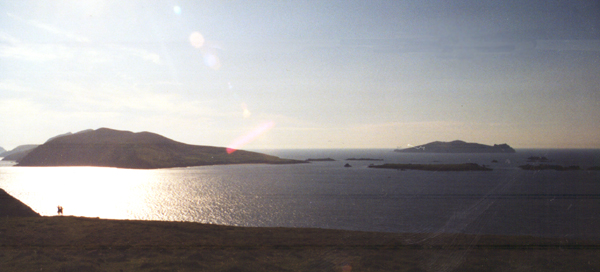The Blasket Islands
/ Irish Times, 29 September 2012
Irish Times, 29 September 2012
LENNY ANTONELLI walks Great Blasket and its lesser-known smaller cousins
OF ALL IRISH islands, Inishnabro offers its rare visitor the grandest entrance. We climb from our ferry into a dinghy and search for a landing spot among the steep rock. Suddenly a sea arch appears, and our boatman steers through it to a hidden cove. We hop out onto the wet rock and up a steep gully to the grassy slopes above.
Inishnabro is one of the Blasket Islands, those last half-drowned scraps of Ireland before the open Atlantic. Much has been written about Great Blasket, home to authors Peig Sayers and Muiris Ó Súilleabháin, which was evacuated in 1953. But little is said of neighbouring islands such as Inishnabro and Inishtooskert.
Without animals to graze it, Inishnabro’s flora seems primeval, a kaleidoscope of colour and texture unseen elsewhere. Its upper slopes are thick with purple heather, spongy sea pink and yellow goldenrod. We hike to the 175m summit, on the north face where the land drops into the sea in a kilometre-long stretch of grassy cliffs.
In 1973, private space flight pioneer Gary Hudson proposed building a spacecraft launchpad here, and said the idea was backed by an astronaut “who walked on the moon”. But according to a memo, a Department of Foreign Affairs official feared the idea could be a “gigantic leg pull”.
But we can’t linger here – we must get to the next island before sea conditions get worse. At Inishtooskert we land on the steep, rocky shore. The odd sight of strangers sends sheep, which are grazing above us, scurrying up a precipitous ridge.
In his book The Blaskets: A Kerry Island Library, Muiris Mac Conghail describes how sheep were taken off Inishtooskert. The men would “pull and and jump with the sheep down the cliff edge, almost becoming in the act sheep themselves”, then embark on the “long row home with a heavy boat with up to 15 sheep tied together”.
We hike up to the island’s highest point, a 172m north-facing cliff, then down to an early Christian oratory and beehive hut, on the south slopes, whose past is grizzly. Tomás and Peig O Catháin were living here around 1850 when a storm cut the island off for six weeks. Tomás died and his body putrified, but his wife was too weak to remove the corpse. There was no other shelter on the island, so she dismembered the body and removed the pieces.
When neighbours from Great Blasket could finally visit, the “woman was alone, nearly dead from hunger, and a maniac”, wrote archaeologist George Du Noyer.
Our boat drops us at Great Blasket next, near the sands of An Trá Bán. The island is essentially a long mountain ridge, and green roads let you explore its wild spine.
Great Blasket’s summit lies near its remote western tip, out of sight of any civilisation, modern or extinct.
From here you have a clear view to the sheer pyramid of Tearaght, the most westerly Blasket and Ireland’s most westerly island, with a lighthouse that clings for dear life to the cliff face.
Tearaght “appears as an astonishing distant rock”, wrote Joan and Ray Stagles in The Blasket Islands: Next Parish America. “More fantasy than reality, far out in the Atlantic, a final punctuation mark to Europe.”
Blaskets
Map : Ordnance Survey Discovery Series 70.
Getting there: Various boat operators including blasketislands.ie, dinglebaycharters.ie
Routes: Inishnabro and Inishtooskert are small so finding the highest point is straightforward. To get to the Great Blasket summit follow the green roads from the village west to Slievedonagh and walk the island’s ridge.
Distance and time: About 12km on the three islands: roughly four hours on the islands and six at sea. Suitability: Our boatman insisted he would only land experienced walkers here.
Photo available from Wikimedia Commons and may be reused according to terms of GNU Free Documentation License
